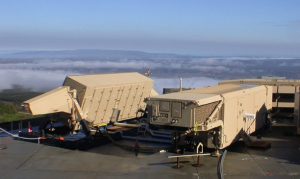U.S. Missile Defense Agency: $2.3Bn Production Contract to Raytheon Missiles & Defense

Raytheon Missiles & Defense, a Raytheon Technologies business (NYSE: RTX), received a $2.3 billion U.S. Missile Defense Agency production contract for seven gallium nitride (GaN)-based AN/TPY-2 radars as part of the Terminal High Altitude Area Defense (THAAD) system, which is designed to protect against incoming ballistic missile threats. The contract is part of a foreign military sale to the Kingdom of Saudi Arabia.
“These highly capable X-band radars are the sharpest eyes in the global missile defense system,” said Bryan Rosselli, vice president of Strategic Missile Defense at Raytheon Missiles & Defense. “The addition of GaN technology delivers capability for threats to be detected, tracked and discriminated with improved radar reliability.”
The mobile AN/TPY-2 missile defense radar uses X-band to clearly see ballistic missile threats. The radar system operates in two modes: forward-based mode — which detects ballistic missiles and identifies any lethal objects as they rise after launch — and terminal mode as part of the THAAD system, which guides interceptors toward a descending missile’s warhead.
Of the 14 AN/TPY-2 radars produced, seven are fielded as a part of U.S.-operated THAAD systems, five operate in forward-based mode for the U.S., and two are part of foreign military sales.
Source: Raytheon Corporation
The AN/TPY-2 Surveillance Transportable Radar, also called the Forward Based X-Band Transportable (FBX-T) is a long-range, very high-altitude active digital antenna array[1][2] X band surveillance radar designed to add a tier to existing missile and air defence systems. It possess a range of 2,900 miles which equals to 4,700 km.[3] Made by Raytheon, it is the primary radar for the Terminal High Altitude Area Defense (THAAD) missile system, but also cues the AN/MPQ-53 radar of the MIM-104 Patriot system. Patriot PAC-3 is a lower-altitude missile and air defense system than THAAD.
The AN/TPY-2 is a missile-defense radar that can detect, classify, track and intercept ballistic missiles. It has two operating modes – one to detect ballistic missiles as they rise, and another that can guide interceptors toward a descending warhead. Once it detects the missile, it acquires it, tracks it, and uses its powerful radar and complex computer algorithms to discriminate between the warhead and non-threats such as countermeasures in order to destroy the missile with a hit to kill kinetic warhead.[4]

